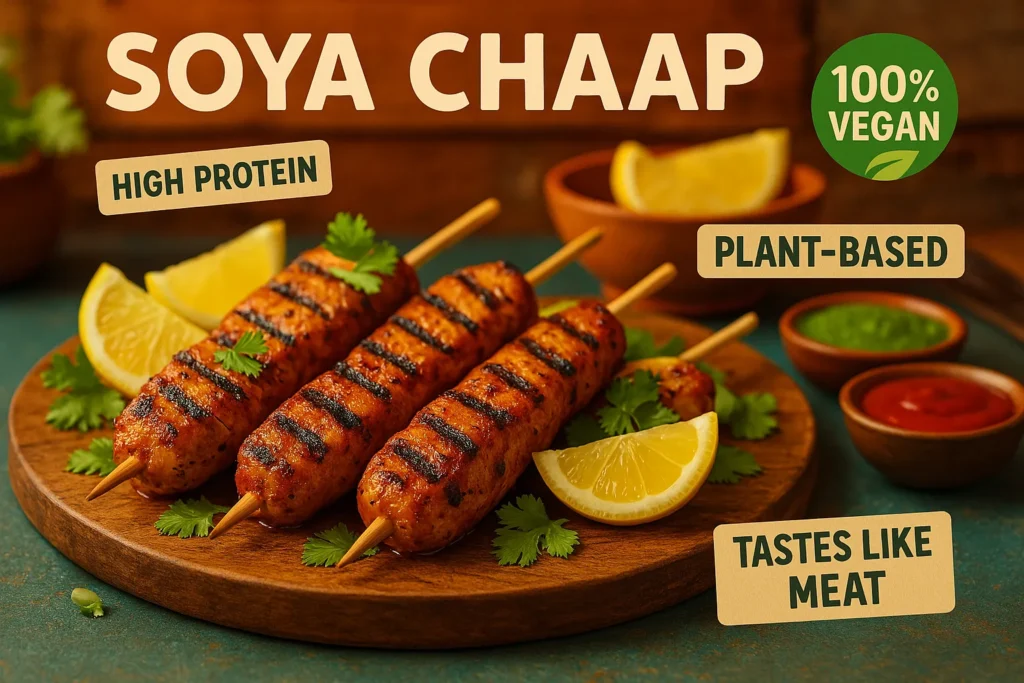Introduction to Soya Chaap
What Exactly is Soya Chaap?
Soya Chaap is a meat-like, high-protein vegetarian food made from soy flour or soy chunks, sometimes mixed with wheat gluten. It’s shaped into sticks or rolls, often served skewered on sticks or cooked in creamy gravies. Basically, it’s like vegan chicken on a stick!
A Quick Look at Its Origin
Originating in North India, Soya Chaap was created as a meat alternative for vegetarians during festive seasons. Over time, its texture and versatility made it a hit, spreading across India and beyond into global food scenes.
Why It’s Gaining Popularity
In a world where more people are turning plant-based, Soya Chaap is becoming a staple. Why? Because it mimics meat in texture, is protein-rich, affordable, and super customizable in recipes. Plus, it tastes so good when marinated right.
Read this also : Is Salt Sneaking Into Your Diet
Nutritional Profile of Soya Chaap
Protein Content and Comparison with Meat
Here’s the kicker: 100 grams of Soya Chaap can pack up to 20–25 grams of protein. That’s nearly on par with chicken breast! For vegans and vegetarians, that’s a game-changer.
Calories and Macronutrients
Per 100 grams, Soya Chaap gives:
- Calories: ~150–200
- Protein: 20–25g
- Fat: 7–10g (mostly unsaturated)
- Carbs: 5–10g
A balanced combo for gym-goers, busy professionals, or anyone needing a plant-based punch.
Vitamins, Minerals, and Fiber
It also contains:
- Iron (good for energy)
- Calcium (for bones)
- Fiber (for digestion)
- Potassium and Magnesium (heart & muscles)
Health Benefits of Soya Chaap
Muscle Building and Fitness Goals
Trying to build lean muscle or shed fat? The high protein content in Soya Chaap makes it an excellent addition to your fitness meal plan. It fuels recovery, builds strength, and keeps you full longer.
Heart Health and Cholesterol Control
Soya is naturally cholesterol-free and low in saturated fats. Consuming Soya Chaap regularly may help reduce LDL (“bad”) cholesterol and support heart health.
Gut Health and Digestion
The fiber in Soya Chaap helps maintain a healthy gut. Plus, it’s light on the stomach when cooked without heavy creams or fried oil.
How Soya Chaap Compares to Other Plant-Based Proteins
Soya Chaap vs. Tofu
Tofu is softer and absorbs flavors easily, but Soya Chaap has a meatier texture. If you’re missing the “chew” of meat, Chaap wins here.
Soya Chaap vs. Tempeh
Tempeh has a nutty flavor and is fermented (which is great for gut health). Soya Chaap, on the other hand, is more neutral and versatile in dishes.
Soya Chaap vs. Seitan
Seitan is higher in protein but contains gluten. Soya Chaap is soy-based and can be gluten-free depending on the recipe. It’s a better choice for soy lovers and those avoiding heavy gluten.
Culinary Versatility of Soya Chaap
Grilled, Roasted, or Curried – Endless Options
Grill it like a kebab, roast it with BBQ spices, or dunk it in a creamy makhani curry – Soya Chaap is a total chameleon in the kitchen.
Adapting Soya Chaap to Global Cuisines
Want Mexican tacos? Toss in grilled Chaap strips. Craving Italian? Sauté it with herbs and tomato sauce. From Indian to Mediterranean to Asian – it blends in beautifully.
Easy Recipes to Try at Home
- Malai Soya Chaap: Creamy, mild, and super indulgent.
- Tandoori Soya Chaap: Spicy, smoky, and grill-friendly.
- Chaap Tikka Wraps: The perfect post-workout snack.
Is Soya Chaap Good for Everyone?
Who Should Avoid It
Those with soy allergies should steer clear. Also, individuals with thyroid issues might need to limit soy intake – always consult a doctor.
Allergies and Sensitivities
Read labels carefully! Some packaged Chaaps have gluten or additives. If you’re sensitive, go for organic or homemade versions.
Soy Myths vs. Facts
Myth: Soy messes with hormones.
Fact: Moderate soy intake is safe and may even help balance hormones in many individuals.
Environmental Impact of Soya Chaap
Sustainable Farming of Soybeans
Soy farming, when done right, uses less land and resources than livestock. It’s one of the most sustainable protein sources globally.
Water Usage Compared to Meat
It takes 10–15x more water to produce 1kg of beef than 1kg of soy. That’s a major win for eco-conscious eaters.
Carbon Footprint Analysis
Livestock farming is responsible for a large chunk of greenhouse gas emissions. Soya Chaap has a fraction of the carbon footprint, making it a climate-friendly option.
Soya Chaap in the Market
Availability in Local Stores and Online
Soya Chaap is now available in supermarkets, Indian grocery stores, and online on platforms like Amazon and BigBasket.
Rising Demand and Popular Brands
Brands like Vezlay, Urban Platter, and GoodDot are bringing innovative soy-based products, including ready-to-cook Chaap.
Future Forecast in the Plant-Based Industry
With the plant-based boom showing no signs of slowing down, Soya Chaap is poised to go global – think soy nuggets, soy wings, and soy burgers made from Chaap!
Final Thoughts
Is It Worth the Hype?
If you’re looking for a plant-based protein that’s tasty, filling, and versatile, Soya Chaap is absolutely worth a try. It’s not just a fad – it’s functional food that fits into modern lifestyles.
What the Future Holds for Soya Chaap
Expect to see Soya Chaap go international – from fine dining to fast food, it’s becoming a plant-powered force to be reckoned with. Watch this space!
FAQs
1. What is the best way to cook Soya Chaap?
Grilling or shallow frying after marinating it enhances flavor. For a juicy texture, simmer it in gravy-based dishes.
2. Is Soya Chaap safe for kids and pregnant women?
Yes, unless they have a soy allergy. It’s a good source of protein and iron.
3. Can I eat Soya Chaap every day?
Moderation is key. A few servings a week are perfectly healthy for most people.
4. How does it taste compared to meat?
It has a slightly chewy, meaty texture that takes on flavors well – very close to grilled chicken or paneer.5. Is Soya Chaap gluten-free?
Some versions are, but others may include wheat gluten. Check the label or make your own to be sure.

